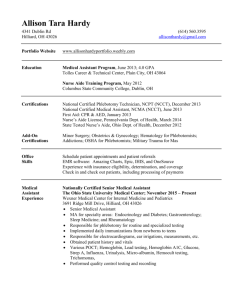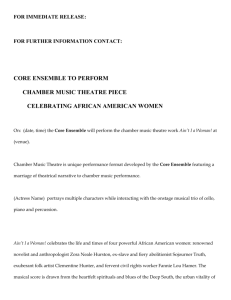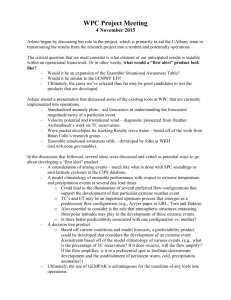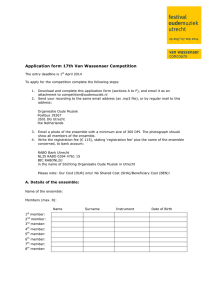Biography & Reviews in Word Format
advertisement
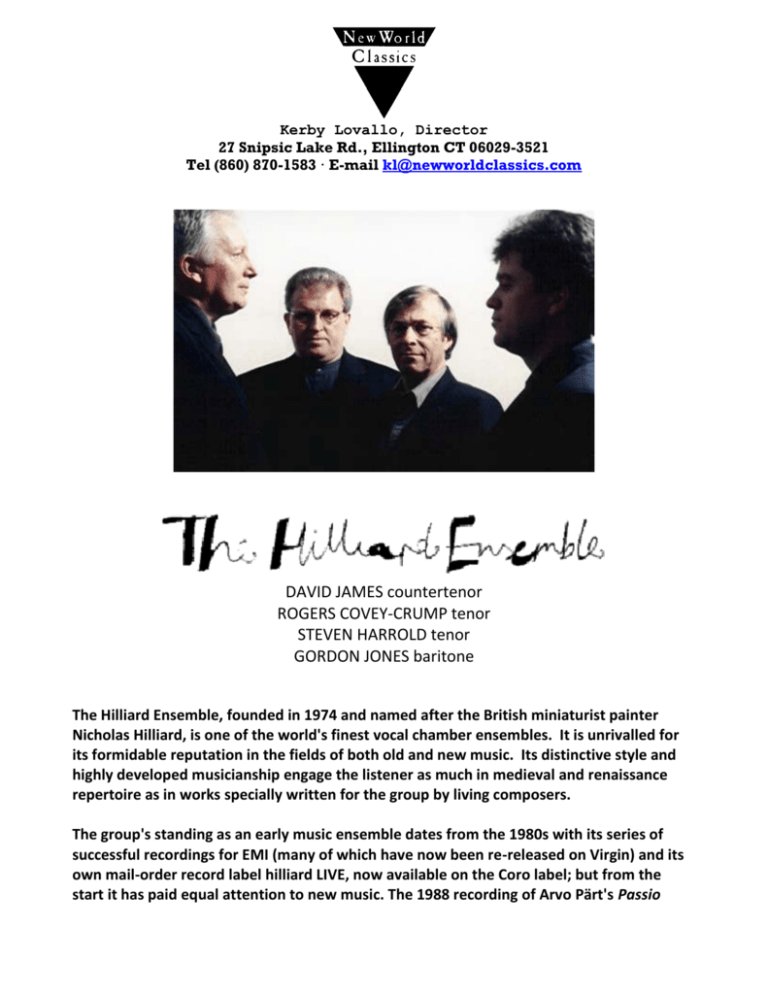
Kerby Lovallo, Director 27 Snipsic Lake Rd., Ellington CT 06029-3521 Tel (860) 870-1583 · E-mail kl@newworldclassics.com DAVID JAMES countertenor ROGERS COVEY-CRUMP tenor STEVEN HARROLD tenor GORDON JONES baritone The Hilliard Ensemble, founded in 1974 and named after the British miniaturist painter Nicholas Hilliard, is one of the world's finest vocal chamber ensembles. It is unrivalled for its formidable reputation in the fields of both old and new music. Its distinctive style and highly developed musicianship engage the listener as much in medieval and renaissance repertoire as in works specially written for the group by living composers. The group's standing as an early music ensemble dates from the 1980s with its series of successful recordings for EMI (many of which have now been re-released on Virgin) and its own mail-order record label hilliard LIVE, now available on the Coro label; but from the start it has paid equal attention to new music. The 1988 recording of Arvo Pärt's Passio began a fruitful relationship with both Pärt and the Munich-based record company ECM, and was followed by their recording of Pärt's Litany . The group has recently commissioned other composers from the Baltic States , including Veljo Tormis and Erkki-Sven Tüür, adding to a rich repertoire of new music from Gavin Bryars, Heinz Holliger, John Casken, James MacMillan, Elena Firsova and many others. In addition to many a cappella discs, collaborations for ECM include most notably Officium and Mnemosyne with the Norwegian saxophonist Jan Garbarek. The fall, Officium Novum will be released on ECM – the latest in this collaboration. The disc Morimur with the German Baroque violinist Christoph Poppen and soprano Monika Mauch was based on the research of Prof. Helga Thoene. It is a unique interweaving of Bach's Partita in D minor for solo violin with a selection of Chorale verses crowned by the epic Ciaconna , in which instrumentalist and vocalists are united. The group continues in its quest to forge relationships with living composers, often in an orchestral context. In 1999, they premiered Miroirs des Temps by Unsuk Chin with the London Philharmonic Orchestra and Kent Nagano. In the same year, James MacMillan's Quickening, commissioned jointly by the BBC and the Philadelphia Orchestra, was premiered at the BBC Proms. With Lorin Maazel and the New York Philharmonic, they performed the world premiere of Stephen Hartke's 3 rd Symphony and they recently collaborated with the Munich Chamber Orchestra with a new work by Erkki-Sven Tüür. In 2007 they joined forces with the Dresden Philharmonic Orchestra to premiere Nunc Dimittis by the Russian composer Alexander Raskatov, also recording this for ECM. A new development for the group began in August 2008 with the premiere at the Edinburgh International Festival of a music theatre project written by Heiner Goebbels in a production by the Th éâ tre Vidy, Lausanne : I went to the house but did not enter . This has subsequently been presented throughout Europe and the US. In the fall of 2010, The Hilliard Ensemble returned to Lincoln Center in New York to showcase their collaboration with saxophonist Jan Garbarek, and in a 2 nd concert with Icelandic alt-rock group Sigur Ros, in a piece created especially for The Hililard Ensemble by the Icelanders. Reviews The Hilliard Ensemble quotes The Rolls-Royce of vocal ensembles. Stephen Hartke, composer The Hilliard Ensemble does ancient music better than just about anyone now. Kenneth LaFave, Arizona Republic, May 2, 2004 Few vocal groups can be recognized within a single bar. The Hilliard Ensemble are one. Their sound is not contrived, their distinctive character having developed organically from their collective musicianship. Matthew Power, Gramophone, May 2004 The astounding melding of the voices of David James, Rogers Covey-Crump, Steven Harrold and Gordon Jones is simply that, astounding, other-worldly. The Hilliard Ensemble are without a doubt one of the finest vocal ensembles in the world. Alan Conter, The Globe and Mail, March 6, 2003 For their performances Their performance was dazzling. The Hilliards managed flawless musicianship from the minute they stepped on the stage to the minute they left. There was not a single note out of tune, not one breath out of place, no voice ever stuck out, sang too loud or too soft. Every syllable was clearly articulated. They were perfect. Tom Czerwinski, The Emory Wheel (Atlanta, GA), April 23, 2004 (Morimur at Spivey Hall April 18, 2004) For Machaut, Motets The five Hilliard singers render these pieces beautifully, in the smoothly blended sound that has become the ensemble's trademark. Allan Kozinn, The New York Times, June 13, 2004 The Hilliard Ensemble remain peerless in this repertoire and bring their customary vocal purity and tonal refinement to this music. Lawrence A. Johnson, Sun Sentinel (Fort Lauderdale, FL), May 21, 2004 the results are magnificent, marked by a combination of technical precision and expressive generosity. The various melodies, each carrying its own poetic imagery, cross and blend exquisitely, and the almost-extravagant sentimentality comes across in piquant contrast to the music's structural ingenuity. Joshua Kosman, San Francisco Chronicle, April 18, 2004 It is a credit to both ECM’s knowledge of its audience and The Hilliard’s musicianship that they can confidently release a disc of esoteric 14th- century motets by Machaut. The result is a rich discovery, imbued with a unique dynamic evolved over three decades. Matthew Power, Gramophone, May 2004 This is a hypnotic, stupendous disc. Alan Rich, LA Weekly, April 22, 2004 Few ensembles have attracted the fervent devotion that England's Hilliard Ensemble has garnered over the last 30 years. Freely traversing early and new music, the Hilliards … have consistently earned praise for their gleaming tone, insightful scholarship and adventurous spirit. These singers burn brightly in this music, adding yet more luster to an already distinguished reputation. Anastasia Tsioulcas, Time Out New York, April 22/29, 2004 The five male voices of the Hilliard Ensemble evoke the aura of a faraway time and place as they perform the difficult music with purity of sound and serenity of spirit. Wilma Salisbury, (Cleveland) Plain Dealer, April 11, 2004 The performances are of a truly mandarin refinement. Here are the Hilliard Ensemble with goodness knows how many combined years of experience performing this kind of music in public; they are not just on the top of their form but also constantly showing the fruits of that experience. David Fallows, Gramophone (UK), May 2004 For Morimur #1 in "The Year in Classical Music; The Critic's Choices" James R. Oestreich, The New York Times, December 23, 2001 Morimur is performed at the highest level. The performances are everywhere engaging and at times truly sublime. James R. Oestreich, The New York Times, December 2, 2001 Reviews January 31, 2006 Music Review | Hilliard Ensemble Some Austere and Layered Sounds of the Renaissance By ALLAN KOZINN The Hilliard Ensemble has lately been exploring the music of the Flemish composer Nicolas Gombert. His music — in particular, his Missa Media Vita and some of his sacred motets — is the subject of the ensemble's latest recording for ECM, and on Sunday afternoon the group sang most of the Mass, a few motets, and pieces by Josquin and Dufay as part of the Music Before 1800 series at Corpus Christi Church. Gombert is a fascinating character. He was born around 1495, reportedly studied with Josquin and thrived in the Spanish chapel of Emperor Charles V until 1540, when he was sentenced to shipboard labor for interfering with one of the choirboys. He was apparently pardoned and spent his last years as a canon at Tournai Cathedral. Like Josquin's, his music is seamless and vibrantly contrapuntal, an effect created by staggered vocal entrances and lines that remain entirely independent until a work's final phrase, when they suddenly coalesce in a rich harmony. More than Josquin, though, Gombert preferred dark timbres, and the Hilliard has added a bass-baritone (Robert Macdonald) to capture that shift. On its Gombert CD, the group sings the Mass with motets interposed. They did the same on Sunday, singing all but the Credo of the Mass, and drawing on a somewhat different motet repertory. A group of pieces from a 12th-century manuscript found at the abbey of St. Martial de Limoges revived an early form of polyphony in which the voices remained tethered together rhythmically, and which sounded strikingly primitive beside Gombert's obsessive counterpoint. And although Gombert was meant to be the composer of the day, two Josquin works — the serene "Tu solus qui facis mirabilia" and a shapely, passionate setting of David's lament for Saul and Jonathan, "Planxit autem David" — proved the most memorable performances. The Hilliard Ensemble's sound, as always, was beautifully blended and subtly shaped, and in this church's acoustic, which is drier than some, it was possible to focus on the individual vocal textures within that blend, an instructive experience typically lost in more ambient settings. ---------------- Wednesday, April 06, 2005 Personals Gaming Web bostonphoenix.com Band Guide the Hilliard Ensemble BY LLOYD SCHWARTZ THE BOSTON EARLY MUSIC FESTIVAL presented England’s renowned Hilliard Ensemble in a program of 15th-century music by Guillaume Dufay and Josquin des Prés at Cambridge’s reverberant St. Paul Church. This quartet — countertenor David James, tenors Rogers Covey-Crump and Steven Harrold, and dour baritone Gordon Jones — have an impeccable sense of pitch and a human quality that many early-music singers seem to avoid. They sing less like angels than like people in the throes of profound devotion. Dufay’s exquisite Se la face ay pale Mass (using a theme he’d composed for a love ballade), with its overlapping waves of æthereal sound, was interspersed with Josquin’s earthier, more richly textured, more directly emotional Bible settings (the Death of Jonathan and Saul — "How are the mighty fallen") and prayers (a heartbreakingly slow Ave Maria). The Hilliards are also admired for their contemporary music. Maybe that’s one reason they never forget they’re singing about something. ---------------------- The Best Classical CD's of 2004 Published: December 12, 2004 MACHAUT: MOTETS Hilliard Ensemble (ECM New Series) This 14th-century poet and composer wrote music whose spare and haunting beauty can at first seem disorienting to modern ears. These motets, in a sumptuous performance by the Hilliard Ensemble, make a wonderful introduction, with their undulating polyphony, shivery dissonances and supple vocal lines, each built around its own poetic text. JEREMY EICHLER --------------Review Published: June 13, 2004 MACHAUT: MOTETS Hilliard Ensemble. ECM New Series 472 400-2; CD. FOR all the strenuous and varied efforts of period-instrument groups and specialized choirs over the last two decades, the music of the 14th-century French composer Guillaume de Machaut has made relatively little headway. This is odd in a personality-driven time, for Machaut essentially invented the notion of the composer as name brand. His predecessors had generally worked anonymously, but Machaut insistently affixed his name to his works, and he spent much of his last decade collecting his scores (and poetry) into an authoritative edition. His "Messe de Notre Dame," the first complete Mass by a known composer, has guaranteed him a place in music history books. Recordings of the Mass are infrequent, and albums drawn from other corners of Machaut's copious output are rarer still. The Hilliard Ensemble helps to redress that neglect with a new selection of 18 motets, secular and sacred songs, in French and Latin. These are exquisite works, structurally unlike the polyphonic vocal works familiar since the Renaissance. Each voice in the fabric has its own text, but the basis and the emotional core of each work is the tenor: usually a brief plainchant melody on a minimal text (sometimes only one word), repeated throughout. Two higher voices — the motetus and triplum, each with its own text — are more expansive. The counterpoint, in other words, is not only musical but also poetic. And the deep emotions evoked in these love songs and devotional texts are mirrored in the play of consonance and dissonance. The five Hilliard singers render these pieces beautifully, in the smoothly blended sound that has become the ensemble's trademark. But Machaut fanciers may bristle at that description. Current thinking in Machaut performance, or at least one school of it, is that vocal production during the composer's time was notably earthier and more rough-hewn than the current finely polished norm. A superb example of that approach can be heard in a recording of the "Messe de Notre Dame" by Marcel Pérès and Ensemble Organum on Harmonia Mundi France. But the art of performing Machaut lies in making conjecture sound convincing. The conjecture the Hilliard singers provide has less to do with historical re-creation than with bringing this marriage of text and music to life for listeners attuned to modern notions of tone. As it happens, the transposition works extremely well. ALLAN KOZINN Posted on Thu, May. 08, 2003 Review: Wild-hare ``Morimur'' convinces the heart if not the mind By PAUL HORSLEY The Kansas City Star "Morimur" is a 70-minute concert that attempts to show that Bach had certain Lutheran chorales tunes in mind when composing his Sonatas and Partitas for Solo Violin. He embedded fragments or numerical patterns of these tunes into the violin texture -according to the theory hatched by German scholar Helga Thoene -- thus imbuing it with hidden meanings relating to faith, death and redemption. On Wednesday, the renowned musicians who recorded "Morimur" for the ECM New Series label -- German violinist Christoph Poppen and the four-voice Hilliard Ensemble -- performed it at Holy Trinity Catholic Church in Lenexa. It's hard to explain why this odd mixture works, but it does. In concert, "Morimur" is even more powerful than it is on the Grammy award-winning disc. On Wednesday, the audience seemed riveted. If at the end we still had doubts about the theories that spawned "Morimur," the sheer beauty of the music won our hearts. Here's how it works: the violinist plays the D-minor Partita, and the singers insert a chorale between each movement. After eight more chorales are sung, the famous Chaconne is played a second time with the chorale tunes sung where they (supposedly) fit into the texture. You don't ordinarily think of hymns as something you want to sit and listen to in concert, but the Hilliards' ravishing, diamond-clear sound made these chorales seem as bracing as any of Bach's more ambitious works. Poppen's deeply studied rendering of the D-minor Partita was continuously engaging. One was drawn to his natural feel for rubato (rhythmic give-and-take) and to his tenacious rhythmic sense. He was appropriately skittish in the Courante and dignified in the Sarabande. His Chaconne was compelling in unconventional ways, and to these ears one of the more distinguished renderings of this piece one can hear today. At times we wished he'd brought his Baroque violin, which he plays on the CD. On the "modern" violin the earlier movements of the suite took on a more languid mood. At times there is a sort of austerity about his playing -- in the Chaconne's rapid arpeggiated passages, for instance -- and on Wednesday this rigor jousted in interesting ways with what is obviously a passionate basic temperament. The big, new-ish Holy Trinity Church was not an ideal space for the venture, a tad dry and with a geometrically complex ceiling that sent echoes bouncing off into odd corners to either side of the altar. "Morimur" was a hit anyway, as good as anything I heard all season MUSIC REVIEW | HILLIARD ENSEMBLE HILLIARD ENSEMBLE, VIOLINIST HELP BACH GET HIS MESSAGES ACROSS Wednesday, May 7, 2003 FEATURES - ACCENT & ARTS 07C By Lynn Green FOR THE COLUMBUS DISPATCH How well do we really know the mind of Johann Sebastian Bach? According to scholars, not well enough. Professor Helga Thoene, of the University of Dusseldorf, has postulated that Bach embedded numerous chorale melodies and hidden numerical messages in his Partita in D minor for violin. The detailed explanations given for Thoene's work are abstruse and scholarly at best, downright confusing at worst. Still, this did not stop Morimur , an arrangement of the Partita for violin and voices, from becoming one of the hottest classical music recordings of last year. Number games and cryptograms were the rage in Bach's time, so it is only natural that he employed them in his compositions. It is well known that he intentionally embedded chorales and the tones B-A-C-H (B-flat) in many of his works. Whether or not listeners believe Thoene's theories, the Hilliard Ensemble and violinist Christoph Poppen brought them to light last night at the Southern Theatre. The parallels may be difficult for average listeners to discern, but this makes Morimur ("we die'') no less enjoyable. To hear a violinist perform the 14-minute Ciaccona once is impressive; to hear it twice is awe-inspiring. Poppen played superbly, with none of the roughness with which many violinists imbue such demanding works. The Hilliard ensemble, a quartet specializing in early and new music, was likewise superb. The chorale Befiehl Du Deine Wege was exquisite enough to make the entire audience hold its breath. Without church or studio reverberation, the music was immediate and personal. The musicians performed with restraint, letting the music's passion speak for itself. Regardless of whether listeners could sense embedded meanings, they could feel something greater hidden here -- and came a step closer to understanding Bach. Sounds that astound By ALAN CONTER Special to The Globe and Mail UPDATED AT 3:38 PM EST Thursday, Mar. 6, 2003 The Hilliard Ensemble Montréal Nouvelles Musiques At Pollack Hall in Montreal on Tuesday Tuesday evening a friend ventured what probably many in the hall were thinking -- that coming into the concert he had assumed that the extraordinary sounds heard on Hilliard Ensemble ECM recordings must include some fancy digital treatment. But no, the astounding melding of the voices of David James, Rogers Covey-Crump, Steven Harrold and Gordon Jones is simply that, astounding, other-worldly. The Hilliard Ensemble, named for the English miniaturist painter Nicholas Hilliard (15471619), are without doubt one of the finest vocal ensembles in the world. Since their founding in 1974 they've built an enviable reputation in both the New Music and Old Music worlds. A lot of very fine music has been created for them, from composers such as Gavin Bryars, John Casken, James McMillan and, of course, Arvo Part. Over the past decade or so they've become somewhat renowned for their singing of songs of the Baltic region. They are featured guests at the Montréal Nouvelles Musiques festival and on Tuesday evening they performed eight short pieces by eight contemporary composers, while on Wednesday they performed the North American premiere of Dutch composer Cornelis de Bondt's Bloed. The Tuesday performance was an eclectic and mostly, though not entirely, pleasing mix. The concert began with Piers Hellawell's The Hilliard Songbook. The work is redolent of early English musical motifs and is a lovely showcase for the remarkable individual and combined voices of all four men. This was followed by the veteran Swiss composer Rudolf Kelterborn's Four Sonnets for Four Voices. While Kelterborn may enjoy a stellar academic reputation, the Four Sonnets suffers from that academic obsession with intricacy that ultimately becomes tedious to listen to and, one suspects, not a whole lot of fun to perform. Relief was not long coming. Elizabeth Liddle, a Scottish composer who lived in Vancouver for a while, offered a delightful work entitled Whale Rant,which she claims to have composed while "obsessed" with Melville's Moby Dick. Light and dark shift in language and tonal colour and bump up against each other in a very fine work that evocative of a Presbyterian hymnal. Then came the world premiere of José Evangelista's Songs of Innocence and of Experience,based on William Blake's poetry. Evangelista has an innate sense of the loveliness of the human voice. With the seven songs of this cycle he transports us through a shifting tapestry of musical colours and textured harmonies on four-note sonorities that flow into heterophony. After the intermission it was time for the world premiere of Torontonian Peter Steenhuisen's Les enfants éternels des gens désespérés. Steenhuisen takes an excerpt of Christian Bok's fabulous Eunoia,a piece that uses only the vowel "e" in a descent into hell, full of hexes. While the singers are given separate and at times colliding lines to sing, the hallucinatory setting is augmented by taped electro-acoustic sources such as recordings of the Afghani instrument the sorna. The canonic singing of the Hilliards didn't quite seem to marry as fruitfully with the electro-acoustic material as one might have wished. The jarring effect, while perhaps in part intentional, seemed not entirely satisfactory. It was if one was listening to two too-separate performances. Joanna Metcalf, an American composer, carried the audience to the poetry of Dante with a piece that, like the Hellawell and Evangelista, evoked earlier musical forms. A lovely work. Arvo Part's And one of the Pharisees was next, using excerpts of the Gospel of St. Luke. The Hilliard's relationship with Part began in 1988 and this latest work shows the intimate connection with the composer. This was an achingly beautiful performance, even for those who might have heard just about enough of the composer that FM radio loves. The final work was by the Russian-German composer, Alexander Raskatov. It is a devotional piece whose music uses the tonal shifts of the Eastern Orthodox liturgical tradition. After the austere Part, it seemed an almost academic pursuit of intricacy. Fine, technical singing, some intriguing moments. But it demanded too much concentration when luxuriating in the earlier sublime moments would have sufficed. Hartford Courant MUSIC REVIEW Hilliard Quartet Weaves Magic By MATTHEW ERIKSON Hartford Courant Staff Writer February 23 2003 The following review is reprinted from Saturday's late editions. The Hilliard Ensemble, a world-renowned a cappella quartet, performed the sacred, soulsoothing strains of early Renaissance composers Dufay and Josquin at Trinity College Chapel Friday night. Founded in 1974-years before a cappella groups such as Chanticleer or The King's Singers had their start-the British-based group has built its sizable reputation on highly engaging performances of old and new vocal repertoire. Friday it turned its attention to the timeless polyphony of the 15th century with interludes of earlier church music. The evening's result was similar to the experience of visiting an ancient European cathedral for the first time: awe-inspiring, edifying, and amazingly beautiful. No doubt the Gothic arches, ornate decor and resonant acoustics of Trinity's chapel added to the impression, as did the sprinkling of sections of Dufay's Mass "Se la face ay pale" throughout the performance. The evening began with the Mass' "Kyrie" and closed with its "Agnus Dei." At times it made applauding these fine and singular musicians more than a little awkward. Dufay's Mass assimilates the best of the Italian, Flemish and French musical elements of his time: weaving independent melodic lines that move elegantly from bursting activity to repose. Expressive, though never emoting, the musichad a rapturous effect. The Josquin motets performed by the Hilliard Ensemble demonstrated a richer range of vocal color and vertical sonority. From the start of the motet "Tu solus qui facis mirabilia" to its end, the voices of the group coalesced splendidly. Other highlights included the heart-rending "Ave Maria," which reached back and forth from canonical to melodic textures. Tenor Steven Harrold gave a solo of early chant that had the beauty and scope of an operatic aria. The group came together in the Josquin motet "O bone et dulcissime Iesu," singing with distinctive delicacy, technical control and brilliant balance. Copyright 2003, Hartford Courant CHICAGO TRIBUNE April 26, 2002 Music review, Performing Arts Chicago's 'Morimur' at St. James Cathedral By John von Rhein Composers have dabbled in musical cryptograms for centuries. Now, it would appear that Johann Sebastian Bach was the greatest cryptographer of them all. In 1994, the German Bach scholar Helga Thoene published a paper arguing that a number of the chorales Bach had written for his cantatas were implied or alluded to in the famous Chaconne from his D-minor Partita for solo violin. The chaconne, she believes, is an elaborately encoded epitaph to Bach's first wife, Maria Barbara. Thoene's thesis, based on numerological clues left behind by the composer, intrigued the German violinist Christoph Poppen. He persuaded Manfred Eicher, the ever-visionary producer of ECM Records, to record Thoene's arrangement of the Chaconne incorporating the encrypted chorales. Eicher brought the four-voice Hilliard Ensemble into the project, and the result was an adventure in speculative musicology called "Morimur." Their ECM disc of that name shot to the top of the charts upon its release late last year. "Morimur" struck a sympathetic chord with many listeners at a time of national unease and mourning. The CD's sleeper success produced a spinoff tour that brought Poppen and the Hilliards to Chicago's St. James Cathedral Thursday under the auspices of Performing Arts Chicago. Whatever credence one was willing to give the scholarly theories behind it, the 70-minute concert made for an absorbing, uniquely moving experience. Following the format of the recording, "Morimur" (the title, "We die," comes from a Latin epitaph, "We die in Christ") interspersed the partita's five movements with the Lutheran chorales Bach is thought to have imbedded in them. The 14-minute Chaconne was played twice — in the solo version and also in Thoene's arrangement for violin and voices singing rhythmically altered versions of the chorales. It would take another musicologist to fathom the arcane evidence Thoene has amassed to support her contentions. Her arguments are convincing but impossible to prove. Is this really what went on in Bach's mind when he was writing the solo violin works? We can never know for sure. On the other hand, decoding Bach's secret language is no mere scholarly exercise if it takes us on so rewarding a musical and spiritual journey. "Morimur" offers music of consolation from across the centuries, presented with enormous skill and deep devotion. A superb, stylish violinist, Poppen shaped Bach's long undulating lines from the inside out. Whether plain or adorned with vocal polyphony, his playing of the Chaconne took on a rapt, ethereal beauty. The Hilliards — Monica Mauch, David James, Steven Harrold and Gordon Jones — intoned the chorales with pure, precise, glowing tone. Bach's music came alive, exquisitely so. TORONTO STAR April 23, 2002 Hilliard Ensemble blends with balance William, Littler Thanks to CBC OnStage program host Eric Friesen for passing on the Hilliard Ensemble's program note for the piece by Canadian composer Jonathan Wild introduced at the last minute into the vocal foursome's Toronto debut recital Friday night at the Glenn Gould Studio. I can't resist sharing it: "Jonathan Wild's Wreath Of Stone was one of several pieces written for us during our residency at Harvard University in 2001. It has a particular connection to the cathedral of Tournon. It was there that the funeral mass for Henry IV was held following his assassination in 1610 and among the readings given in tribute was the text of this piece. "The epitaph is a curiosity in itself. If read at the correct speed in the right acoustic, that of Tournon cathedral, the last syllables of each line of the Greek text will be heard as an echo, but in French, forming a shorter poem, also about the death of Henry. "As if this were not complex enough, the first letters of each line of the Greek spell out Errikos Borbonis Henry of Bourbon, as Henry IV was also known." Breathtaking, no? The wonder is that Wild's music sounded nowhere near so complicated as the text it was setting. Extended vocal techniques were scarcely evident. The harmonies, while sometimes unconventional, presented no great listening challenge, and the whole work sounded like nothing so much as a modern response to centuries-old liturgical tradition. In fact, the other recent pieces on the program (also written specially for the Hilliard) by Joanne Metcalf, Karen Thomas and Alexander Raskatov, although in different languages, similarly, in varying degrees, represented modern interpretations of traditional approaches to text setting. No wonder they blended in so well when performed between music of the 14th, 15th, 16th centuries by Guillaume de Machaut, Jacquet de Mantua, Nicolas Gombert and Orlando di Lasso. I've seldom heard a program of late in which music composed over such a broad span of time came together into such a harmonious whole. Part of the explanation doubtless lay with the way it was sung. Since their coming together in 1974, the members of Britain's Hilliard Ensemble have helped set the standard for small male vocal ensembles, producing some of the most exquisitely blended, beautifully balanced quartet singing to be heard on the concert stage. The sheer clarity and purity of the way counter-tenor David James launched into Metcalf's Il nome del bel fior: Maria I, the voice soaring aloft unaccompanied, ravished the ear, and as he and his colleagues (tenors Rogers Covey-Crump and Steven Harrold and baritone Gordon Jones) continued through the rest of their program, the vocal standard never faltered. Of particular note among the newer works was Alexander Raskatov's Praise, written for the foursome in 1998 with five sections, all in old church Slavonic, from the Liturgy of St. John Chrysostom. This was praise depicted in a sober Russian rather than bright western manner, incorporating spoken as well as sung words, but full of interesting musical ideas and very convincingly sung. With an extensive discography on the EMI, Virgin and ECM labels, it is hard to believe that it has taken 28 years for the Hilliard Ensemble to reach our shores. May its return be a speedy one. ----------------------------



